The Spoilsport, Coral Sea, AustraliaContents of this Issue: The Spoilsport, Coral Sea, Australia Another Cozumel Propeller Accident How Not to Lose $95 in a Bonaire Tourist Tax Scam Lost and Found - How Lucky He Is Turneffe Island Resort, Belize, C.A. Ships May Be Fueling a Coral-Killing Epidemic A Painful Ear Infection from Polluted Indonesian Seas Cozumel Diver Disappears from Surface And Don't Forget about RipTides Mexico Closes Down Great White Shark Cage Diving Dave Crosby was a Serious Diver Red Sea Liveaboard Smacks into a Reef at Night Editorial Office: Ben Davison Publisher and Editor Undercurrent 3020 Bridgeway, Suite 102 Sausalito, CA 94965 fine boat, pristine diving from the February, 2023 issue of Undercurrent
Dear Fellow Diver: When something is worth doing, I believe it's worth doing to excess. That said, I booked back-to-back seven-day trips to dive the Coral Sea aboard Mike Ball's well-regarded Spoilsport. I had a traveling companion for the first leg, but for the second week, I was a stray, a single woman diver, so I appreciated the pre-departure gathering at the pub around the corner from Ball's Cairn's office. I peered at name tags and made a bit of small talk with my new traveling companions (Australians, New Zealanders, North Americans, ex-pat Brits, and Singaporeans). Eventually, a couple of Spoilsport's crew led us across the road to the boat. Over a glass of sparkling wine, we listened to an exhaustive orientation as the Spoilsport left on our overnight passage to the seamounts of the Coral Sea.
By 9:30, my buddy and I hit the water off the Nonki Bommie at Holmes Reef. Nonki rises from about 35 meters to a few meters from the surface and has a cleft at the top filled with huge, photogenic sea fans -- a spectacular first dive. I was slightly under-weighted, so my buddy lent me a 1kg weight, then we swam down to 28m and began to spiral up. Belying their ugly name, two spectacular big nose unicornfish carried on a territorial dispute, with lightning-fast color changes from dusky black, through electric blue markings, to ashy gray, with their long tail filaments rippling as they weaved around each other. At the top of the bommie, Pablo Cogollos, the expedition photographer, waited in the sea fan cleft for photo opportunities to immortalize his guests against the stunning backdrop. After the second dive, Russell, the skipper, moved Spoilsport to a site named "Amazing" because of the maze of bommies rising from pure white sand. After a long surface swim along the mooring line, we descended. My buddy found a huge crown of thorns, which she prodded lightly with her reef pointer, watching it turn from almost brick red to a pale gray. There were jewel damselfish, with tiny blue spots and golden eyes, guarding their cultivated turf gardens, busily chasing off herbivorous tangs -- and divers. After dinner -- and twilight dive if we wanted -- we began our overnight passage to Bougainville Reef. By 6.30 the next morning, we were moored at the wreck of the Antonio Tarabocchia, a 460-foot Italian cargo ship that ran aground in 1961. I was woken by Kerrin calling out, "wakey, wakey!" A cheerful fellow, he was good-humored throughout the trip despite working long hours. I headed to the coffee machine in the salon, grabbed a mouthful of fruit salad, listened to the dive briefing, and hit the water at 7:35 a.m. I was soon at the wrecked engine block. The prop shaft extended away across the reef top, where a large school of trevally swam. The reef is exposed and bare, with unidentifiable pieces of the wreck cemented into the reef by concretion (a chemical product of iron from the wreck and calcium salts in the seawater, which looks like manufactured concrete). We found the boiler in about 15m of water, surrounded by a forest of branching corals. As a macro nut, I was happy to see little red-spotted guard crabs and scarlet coral hawkfish. I had traveled to Cairns with two friends. The first week, my buddy and I shared a small bunk bed cabin; one had to be reasonably nimble to climb to the top bunk. But the mattresses were comfortable. The adjustable cabin air-conditioning kept me cool at night. The shower, equipped with luxurious towels, gave plenty of hot water. The small cabin was no bother since I only used it for changing clothes or sleeping; I could relax in the salon or open-air top deck. With a full complement of 28 divers (plus crew) trying to dive at once, everyone's goodwill and good manners are a must. Each diver is allocated a bench place, and the tanks are refilled in situ with air or nitrox. The trip director briefed us at each site, sketching details on a whiteboard. Experienced divers were on their own -- the maximum air depth was 130 feet. An instructor accompanied the inexperienced, out-of-practice, or apprehensive divers until judged competent to dive unsupervised. A Singaporean couple, experienced divers unaccustomed to diving on their own, had a crew member accompany them. Solo divers were matched by experience/air consumption. The first week, our traveling companion, Keith, was buddied with a man who used air so fast he would finish a dive in 30 minutes, which did not suit Keith well, but he had some flexibility to join us when his buddy surfaced. I had an assigned buddy in my second week who matched my air consumption. I was keen to take the last spot available on my second week, so my cabinmate was a nice guy from Minnesota; we quickly worked out an easy-going routine for preserving modesty for both of us.
Regardless of the GBR's coral bleaching problems, we were farther out in the Coral Sea, where diving is exceptional. It falls loosely into three categories: big fish or schools of fish; stupendous walls and coral scenery; or sea fans and soft corals. Often all three at once. We spent the first three days on Holmes, Bougainville, and Osprey reefs, with occasional long swims to get to the wall. The crew was happy to pick up divers who needed it. The water was warm 82°F at the end of October (late spring), and most divers were comfortable in 3mm of neoprene or even fabric suits. I wore a 5mm wetsuit. At the North Horn of Osprey Reef, the guides held a shark feed, assuring us that the amount of food was so small the sharks would not become dependent on handouts. The first to arrive were lithe grey reef sharks with their hitchhiking remoras, followed by a solitary whitetip reef shark. Red bass and a school of beautiful bluefin trevally joined, with a couple of small (less than 4-foot) potato cod cruising in once the riff-raff had arrived. At least one grey shark had a tag attached to its dorsal fin. We gathered around the walls of a natural amphitheater, and a bin with a couple of tuna heads was lowered down. The sharks and other predators circled the amphitheater, providing plenty of photo opportunities before the staff diver opened the bin, and the tuna heads shot up like a jack-in-the-box. There were 10 seconds of a writhing feeding frenzy, and then it was all over. (The second week a shark researcher joined us to check on the acoustic transponders he uses to track the tagged sharks.)
Pablo drove the Spoilsport's drone for aerial shots and took photos of divers at photogenic locations. A marine biologist who studied at the Universidad Autonoma de Madrid and has been trained as a Great Barrier Reef Master Guide, he delivered upbeat evening lectures on reef and seamount biology. He also organizes Mike Ball's photo competition; the photos voted "best" by guests are entered in an annual contest where the winner gets a free week on the Spoilsport. Because the photographic possibilities are endless, I relied on his advice on which lens to use at a new site. I prefer macro, and I was disappointed at the few critters I spotted: a handful of nudibranchs, a few crustaceans, and no anemone shrimps. I did see four species of coral crabs. We motored back to the edge of Australia's continental shelf, spending time at Cod Hole before motoring to the Lighthouse Bommie, so-called because it is a lighthouse-shaped spire. The base is about 30m down, but it is most spectacular at 10m, where I spiraled up in a lazy corkscrew. Plenty of soft corals and mimic filefish, blennies, and the ubiquitous arc-eye hawkfish fish lived in the crevices. In mid-water, yellow blue-lined snapper, red bass, and yellowtail fusiliers cruised past. Blue-green pullers and anthias swarmed in the shallows. On my night dive safety stop, with torches off, I was hanging on to the mooring line when my gloved hand felt something large and really weird attached to the line. With a pulpy feel. With my hand, I patted and probed the thing, trying in the darkness to work out what on earth it might be. At that moment, my buddy batted me about the head and shoulders, and I heard "Git off!!" through her mouthpiece as she pulled her hand away. It struck me as hysterical, and I dissolved in a cloud of bubbles. My dive log notes for the one dive I did at the Vertical Gardens site at the Southern end of No. 10 Ribbon Reef read like a schoolgirl's journal, with multiple exclamation points and (I blush) even emojis. It was one of the most memorable dives I have done in my 50-year diving career, with a 40m vertical drop-off, sea fans and soft corals, artistically placed hard-coral outcrops, clouds of small fish, schools of fusiliers, and ever-changing vistas. Seventy minutes in the water was not nearly long enough, especially since it was too windy the second week to dive there.
On the dive deck are a central (wet) rack for cameras, two easily accessible air lines for blowing water off housings, a couple of 240v power points for chargers, and a rinse bucket. The rack is first come, first served. Since I'm temperamentally disinclined to confront a TG5 owner with the territorial instinct of a Titan triggerfish to get space on the camera rack, I did all my lens and battery changes in my cabin.
It was difficult for me to go home after such a great boat and excellent diving, but to keep the memories alive, Pablo's photos and videos are available to download a few days after the trip. He sets his trip documentary to music, and while slightly formulaic, it's a wonderful way to convey the magic of the trip to friends and relatives . . . . and to bring back fine memories. But not everyone's trip ended with pleasant memories. Passengers were required to return a negative COVID test before boarding. The COVID virus is a tricky bugger and can flourish in the cramped and cozy spaces of a liveaboard. Social distancing is nearly impossible. My two traveling companions tested positive the day after returning home, so they likely contracted COVID while on board. I'm sure Pablo's photos and videos helped them get through it. -- T.A. Author's Bio; With more than 1000 dives logged, our author learned to dive in the U.K. in the '70s, worked in Eilat when the Israelis still controlled the Sinai Peninsula to the Straights of Tiran and dived Truk when the Thorfinn was still a steamship and not a floating backpacker shack. In the last decade, Southeast Asia, Raja Ampat, and the Philippines have been on the agenda, not to mention the cold waters of Tasmania, including kelp and muck dives in the Derwent River.
|

I want to get all the stories! Tell me how I can become an Undercurrent Online Member and get online access to all the articles of Undercurrent as well as thousands of first hand reports on dive operations world-wide
| Home | Online Members Area | My Account |
Login
|
Join
|
| Travel Index |
Dive Resort & Liveaboard Reviews
|
Featured Reports
|
Recent
Issues
|
Back Issues
|
|
Dive Gear
Index
|
Health/Safety Index
|
Environment & Misc.
Index
|
Seasonal Planner
|
Blogs
|
Free Articles
|
Book Picks
|
News
|
|
Special Offers
|
RSS
|
FAQ
|
About Us
|
Contact Us
|
Links
|
3020 Bridgeway, Ste 102, Sausalito, Ca 94965
All rights reserved.

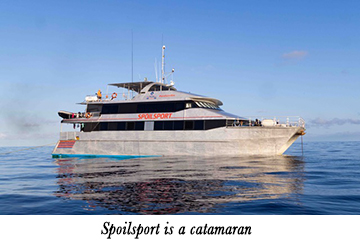 On my first week, with seas on the stern quarter, it was a bumpy and uncomfortable journey (the website proclaims, "Spoilsport has a twin hull design which maximizes stability and passenger comfort in all conditions."). Some guests, unprepared for the motion (I guess they believed the website), didn't show up for breakfast the next morning. Kerrin, the trip director, gave us a rundown on dive procedures (for example, "don't leave batteries charging unattended in your cabin,") and we all know why).
On my first week, with seas on the stern quarter, it was a bumpy and uncomfortable journey (the website proclaims, "Spoilsport has a twin hull design which maximizes stability and passenger comfort in all conditions."). Some guests, unprepared for the motion (I guess they believed the website), didn't show up for breakfast the next morning. Kerrin, the trip director, gave us a rundown on dive procedures (for example, "don't leave batteries charging unattended in your cabin,") and we all know why).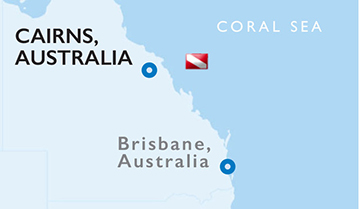 After two American liveaboard divers disappeared on the GBR two decades ago (remember the movie Open Water?), checking divers in and out of the water has become meticulous. Each diver must carry an SMB and was loaned a Nautilus Lifeline as we were diving 200 miles from Cairns. You enter with a stride off the 5-foot-high dive platform (or, if you prefer, from the water-level re-entry platforms) and exit up a sturdy single-spine monkey pole ladder. They lifted cameras and offered help, preferring that you keep your fins on until you were out of the water. They'll lift your gear if you cannot climb the ladder fully laden -- as we age, many can't, so no embarrassment. Once you're on the re-entry platform, they pull off your fins then you clamber up the steps to the dive deck, where a crew member notes dive time and depth. All the while, a lookout on the top deck with a two-way radio oversees divers in the water.
After two American liveaboard divers disappeared on the GBR two decades ago (remember the movie Open Water?), checking divers in and out of the water has become meticulous. Each diver must carry an SMB and was loaned a Nautilus Lifeline as we were diving 200 miles from Cairns. You enter with a stride off the 5-foot-high dive platform (or, if you prefer, from the water-level re-entry platforms) and exit up a sturdy single-spine monkey pole ladder. They lifted cameras and offered help, preferring that you keep your fins on until you were out of the water. They'll lift your gear if you cannot climb the ladder fully laden -- as we age, many can't, so no embarrassment. Once you're on the re-entry platform, they pull off your fins then you clamber up the steps to the dive deck, where a crew member notes dive time and depth. All the while, a lookout on the top deck with a two-way radio oversees divers in the water.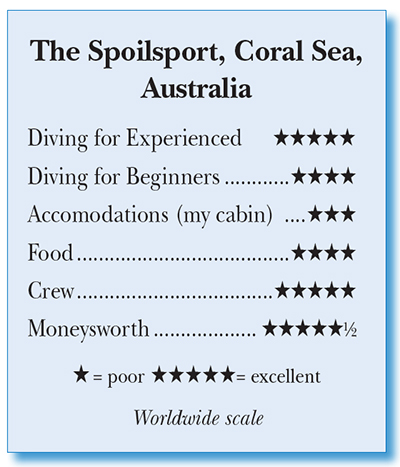 Even the least interesting dives were very good; the best were world-class. The excellent visibility, up to 100 feet, and dramatic underwater scenery led me to work on my wide-angle skills. At False Entrance on Osprey Reef, Pablo swam up and pointed at his camera's LCD screen, which showed a school of big-eye trevally. He gestured for us to follow him, a sprint of maybe 300m. A big school of trevally came into sight as we swam into a canyon, and I spent a happy 10 minutes surrounded by great swirling silvery fish.
Even the least interesting dives were very good; the best were world-class. The excellent visibility, up to 100 feet, and dramatic underwater scenery led me to work on my wide-angle skills. At False Entrance on Osprey Reef, Pablo swam up and pointed at his camera's LCD screen, which showed a school of big-eye trevally. He gestured for us to follow him, a sprint of maybe 300m. A big school of trevally came into sight as we swam into a canyon, and I spent a happy 10 minutes surrounded by great swirling silvery fish.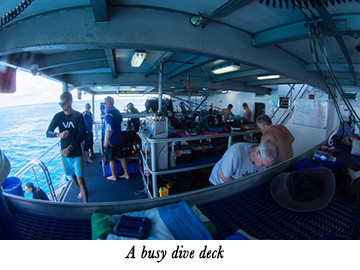 If you're out to sea for a week, it's essential that the meals are good, and indeed they were excellent, with plenty of fresh fruit and vegetables. This is, of course, not down to chance; the sequence of meals on the two trips was almost identical. Meals are help-yourself buffets, except for the Restaurant Night, a three-course, sit-down, waiter-served dinner. At breakfast, we were offered a full cooked breakfast and continental buffet options. Lunch might include hot soup, cold meats, vegetarian quiches, Caesar salad, smoked salmon, and fresh fruit. Dinner often had a cuisine theme and (free) wine served at the table. The crew ate after guests had helped themselves from the buffet -- I (deservedly) got a gentle rap on the knuckles for wandering up to dinner late and keeping the unfortunate crew waiting.
If you're out to sea for a week, it's essential that the meals are good, and indeed they were excellent, with plenty of fresh fruit and vegetables. This is, of course, not down to chance; the sequence of meals on the two trips was almost identical. Meals are help-yourself buffets, except for the Restaurant Night, a three-course, sit-down, waiter-served dinner. At breakfast, we were offered a full cooked breakfast and continental buffet options. Lunch might include hot soup, cold meats, vegetarian quiches, Caesar salad, smoked salmon, and fresh fruit. Dinner often had a cuisine theme and (free) wine served at the table. The crew ate after guests had helped themselves from the buffet -- I (deservedly) got a gentle rap on the knuckles for wandering up to dinner late and keeping the unfortunate crew waiting.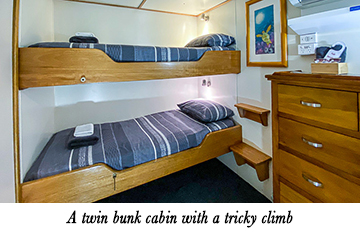 Three-quarters of the crew changed for the second week -- including the skipper, first mate, chef and trip director roles -- so it gave me a chance to wonder whether the operation of Spoilsport was affected by the different crew on the boat. My verdict: Different personalities, chalk and cheese, but from my point of view, alike in running a tight ship.
Three-quarters of the crew changed for the second week -- including the skipper, first mate, chef and trip director roles -- so it gave me a chance to wonder whether the operation of Spoilsport was affected by the different crew on the boat. My verdict: Different personalities, chalk and cheese, but from my point of view, alike in running a tight ship. Divers Compass: The eight-day, seven-night Coral Sea trips run between US$3000-US$4300, depending upon accommodations . . . . Mike Ball offers a wide range of trips, including a five-day trip with a round-trip helicopter ride to Turtle Island (one of the world's top resorts) for boarding, thereby avoiding an overnight cruise to Cairns . . . . It's possible to do five dives a day; I paced myself and did 40 dives over 12 days . . . . The "face" of Mike Ball's office (or voice on the phone) is the incomparable Dorothy, with efficient pre- and post-trip organizing . . . . To reach Cairns from the U.S., one must first fly to Sydney or Brisbane. . .
Divers Compass: The eight-day, seven-night Coral Sea trips run between US$3000-US$4300, depending upon accommodations . . . . Mike Ball offers a wide range of trips, including a five-day trip with a round-trip helicopter ride to Turtle Island (one of the world's top resorts) for boarding, thereby avoiding an overnight cruise to Cairns . . . . It's possible to do five dives a day; I paced myself and did 40 dives over 12 days . . . . The "face" of Mike Ball's office (or voice on the phone) is the incomparable Dorothy, with efficient pre- and post-trip organizing . . . . To reach Cairns from the U.S., one must first fly to Sydney or Brisbane. . . 